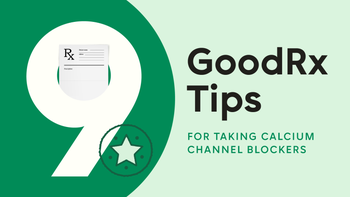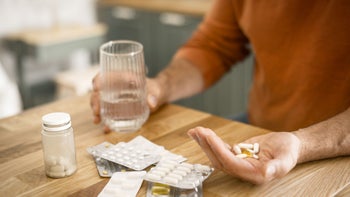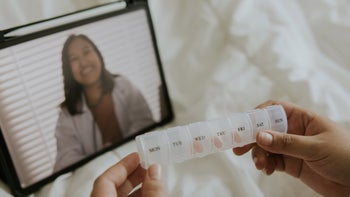
15 Amlodipine Side Effects You Should Know About: Swelling, Fatigue, and More
Key takeaways:
Amlodipine (Norvasc) is a medication used to treat high blood pressure and coronary artery disease. Swelling, fatigue, palpitations, and flushing are the most common side effects of amlodipine.
Several amlodipine side effects are more common with higher doses. And some have been reported more frequently in women than men.
Contact your prescriber if side effects you’re experiencing become bothersome or don’t go away. They may adjust your dose or switch you to a different medication.
Access savings on related medications
Table of contents

Amlodipine (Norvasc) is a common medication used to treat high blood pressure (hypertension). In fact, it’s often one of the first-choice medication options for the condition. And it’s used to treat certain types of angina (chest pain) and coronary artery disease (CAD), too.
Amlodipine belongs to a medication class called calcium channel blockers. It helps lower your blood pressure by causing blood vessels to relax and widen throughout your body. This also helps with chest pain, since your heart doesn’t have to pump as hard.
Even though it’s commonly used, is amlodipine safe? It’s known to cause bothersome side effects such as swelling, fatigue, and dizziness. But how common are amlodipine side effects, and is there anything you can do about them?
Amlodipine side effects at a glance
Common amlodipine side effects (reported by greater than 1% of people during clinical trials) include:
Swelling
Flushing
Heart palpitations (pounding or racing heartbeats)
Fatigue
Nausea
Dizziness
Abdominal pain
Drowsiness
Less common amlodipine side effects include:
Weight gain
Increased urination
Sexual problems, including erectile dysfunction
Muscle tremors
Shortness of breath
Low blood pressure
Worsening chest pain and heart attack in certain people
Below, we cover 15 amlodipine side effects in greater detail, plus ways to manage them.
1. Swelling in your legs or ankles
Swelling of the legs or ankles (edema) is one of the most common amlodipine side effects. It happens because amlodipine dilates your blood vessels, which improves blood flow. But this can put pressure on smaller blood vessels (called capillaries), causing fluid to leak out into surrounding tissues. When it occurs, swelling usually happens in both legs.
Swelling is more likely to happen with higher doses of amlodipine (like 10 mg daily). And women were about 2 to 3 times more likely to report swelling compared to men during clinical trials.
Talk to your prescriber if you experience swelling from amlodipine. They can determine if it’s likely from your medication or something else. That’s because many other medications and health conditions can cause swelling in your legs, too.
They may recommend elevating your legs periodically throughout the day or trying compression socks. Other options may include lowering your dose or switching you to a different medication.
2. Fatigue
Amlodipine may make you feel tired or fatigued. Unlike certain other side effects, this doesn’t seem to be related to the dose you’re taking.
Amlodipine tips: Is there a best time to take amlodipine? Here, pharmacists provide tips for when and how to take amlodipine to get the most out of your medication.
Real stories: Three people describe what it’s like to take amlodipine, including how they managed side effects from the treatment.
Amlodipine interactions: Learn more about amlodipine interactions — from statins to Viagra — and how to manage them.
It’s possible for blood pressure medications to make you feel tired. And your fatigue may improve over time as your body adjusts to the medication. But there are a few things you can do to help boost your energy, including exercising regularly and making heart-healthy food choices.
Tell your prescriber if your fatigue is bothersome, or if it’s accompanied by other symptoms, such as shortness of breath or chest pain.
3. Dizziness
Dizziness is another amlodipine side effect that’s more likely to happen with higher doses. You may also notice some dizziness as your body adjusts to the blood pressure changes from amlodipine, especially within the first few days of taking it. This should improve over time.
You may feel dizzy when you go from lying down or sitting to standing up. So be careful when changing positions. If you’re feeling dizzy, sit or lie down until the feeling passes. Be sure to drink enough fluids, since dehydration can worsen dizziness.
Tell your prescriber right away if your dizziness becomes persistent or bothersome. This may be a sign that your amlodipine dose is too high, or that other medications you take need to be adjusted.
4. Weight gain
Amlodipine doesn’t typically cause weight gain. But you may notice changes in your weight if your body is retaining more fluid. As mentioned above, this can show up as swelling in your legs or ankles.
If you have heart failure, weight gain — especially if it happens over a short period of time — can be concerning. This can be a sign that your heart isn’t pumping well enough, causing fluid buildup in your body. Report any rapid or significant changes in your weight to your healthcare team while taking amlodipine.
5. Fast or irregular heartbeat
Fast or irregular heartbeats (palpitations) are a possible side effect of amlodipine. When it happens, your chest may feel like it’s pounding or fluttering. During clinical trials, women were more than twice as likely to report palpitations compared to men. It’s also more likely to happen with higher doses.
Tell your prescriber right away if your palpitations are lasting longer or start happening more often. Seek immediate medical attention if they’re accompanied by other symptoms, like shortness of breath, chest pain, or loss of consciousness.
6. Nausea or stomach pain
Many medications can cause nausea, and amlodipine is no exception. Stomach pain is also possible. But this is usually mild and rarely causes vomiting.
You can take amlodipine with or without food. If you’re feeling nauseated after you take a dose, try taking it with food next time.
7. Flushing (redness of neck, face, chest, or arms)
Flushing is possible while taking amlodipine. It can cause your skin to look red or feel warm to the touch. Some people experience it as a result of blood vessels widening.
Flushing is more likely to happen with higher doses of amlodipine. And women were also three times more likely to report flushing than men during clinical trials. As with several other side amlodipine effects, flushing should improve over time.
8. Erectile dysfunction
While uncommon, some people have reported erectile dysfunction (ED) while taking amlodipine. However, it’s important to note that ED can have many other causes, including high blood pressure. And ED is more likely with other blood pressure medications, such as thiazide diuretics and beta blockers.
If you’re experiencing ED after starting amlodipine, let your healthcare team know. They can determine the underlying cause and best next steps.
Keep in mind that ED medications like Viagra (sildenafil) can interact with amlodipine, causing your blood pressure to drop. Check with your healthcare team before taking an ED medication with amlodipine.
9. Increased urination
Urination problems are possible with calcium channel blockers, including amlodipine. This is because they can interfere with how your bladder fills, contracts, and empties. You may notice that you need to pee more frequently or that you’re getting up at night to use the bathroom.
People with benign prostate hyperplasia (BPH) may be more likely to experience urination problems with amlodipine. But this can happen to anyone taking the medication. Talk to your prescriber if this side effect starts affecting your quality of life. They may adjust your dosage or suggest an alternative medication.
10. Abdominal pain
Although it’s not particularly common, amlodipine can cause abdominal pain. But this could be a sign of pancreatitis if it’s severe and accompanied by other symptoms, such as nausea and vomiting, fever, and/or jaundice (yellowing of skin and eyes). Acute pancreatitis can be life-threatening. Get immediate medical attention if these symptoms develop.
11. Drowsiness
Drowsiness is a possible amlodipine side effect, reported by less than 2% of people taking it. And it doesn’t seem to be related to your dose. Because of this, it’s best to avoid driving or performing other tasks that require you to be alert until you see how the medication affects you.
12. Low blood pressure
Low blood pressure (hypotension) is possible with any medication used to treat high blood pressure, including amlodipine. It’s more likely to happen with high doses, or if you take amlodipine with other medications that also lower blood pressure.
Common symptoms of low blood pressure include blurred vision and feeling lightheaded or dizzy. A fast or irregular heart rate, confusion, and fainting are more serious symptoms that warrant emergency medical care.
13. Worsening chest pain or heart attack
In rare cases, amlodipine can worsen chest pain, or even raise the risk of a heart attack. This risk seems to be highest in people with severe CAD after starting amlodipine or raising their dose.
Despite these rare risks, amlodipine has been shown to lower the risk of cardiovascular events, including heart attack.
Call 911 or seek immediate medical attention if you experience new or worsening chest pain.
14. Muscle tremors
While uncommon, some people taking amlodipine during clinical trials reported muscle tremors (shakiness). Stiff muscles and abnormal muscle movements have also been reported. If you notice shaky or stiff muscles, or any other movement changes, tell your prescriber right away. They may have you stop taking amlodipine.
15. Shortness of breath
Shortness of breath has been reported by some people taking amlodipine. There are a few things to keep in mind if this happens while taking amlodipine.
Exercise: Blood pressure medications can make you feel more tired than usual. And some can slow your heart rate, including amlodipine. So you may experience more breathlessness while exercising. Talk to your healthcare team about how to safely incorporate exercise into your routine.
Fluid buildup in the lungs: Some people with heart failure have reported fluid buildup in the lungs while taking amlodipine. In this case, report shortness of breath to your prescriber right away.
Chest pain or heart attack: Shortness of breath that happens with severe or worsening chest pain can indicate something more serious, such as a heart attack.
Tell your prescriber if you experience persistent shortness of breath while taking amlodipine. Get emergency medical attention if it’s severe, especially when accompanied by symptoms such as chest pain.
When to contact your healthcare team about amlodipine side effects
Many amlodipine side effects can be managed at home and may improve over time. But if any side effects start interfering with your quality of life, talk to your prescriber. They can suggest management tips, which may include lowering your dose or switching you to a different medication.
Some amlodipine side effects require medical attention, such as very low blood pressure, severe abdominal pain, and chest pain. If any symptoms feel severe or life-threatening, call 911 or go to the nearest ER.
Frequently asked questions
There are a few ways to manage swelling from amlodipine. Examples include:
Elevating your legs throughout the day
Incorporating more movement into your daily routine to prevent fluids from pooling in your legs and ankles
Wearing compression socks to help push fluids out of your legs
Eating less salt, since it can cause you to hold onto more fluid
There aren’t any foods or drinks that you need to avoid entirely while taking amlodipine. But there are some that you may want to limit, including:
Salty foods, such as pizza, chips, and condiments
Ultra-processed foods, such as packaged snacks, ready-made meals, and fast foods
Cured meats and cheese
Caffeinated beverages, such as energy drinks
Sugary foods, such as baked goods and ice cream
If you think you’ve taken too much amlodipine, contact your prescriber right away. You can also contact Poison Control for guidance at 1-800-222-1222 or online. Go to the nearest ER if your symptoms feel severe or life-threatening. Symptoms of an amlodipine overdose can include:
Very low blood pressure
Confusion
Difficulty breathing
Fast, slow, or irregular heartbeats
Slurred speech
Nausea and vomiting
The bottom line
Common amlodipine (Norvasc) side effects include swelling, fatigue, and flushing. Nausea, erectile dysfunction (ED), and increased urination are also possible.
Some amlodipine side effects are temporary and improve as your body adjusts to the medication. And some are more common with higher doses. Talk to your prescriber if any side effects become bothersome. They may decide to lower your dose or switch you to a different medication.
Why trust our experts?



References
Handler, J. (2010). Resistant hypertension responding to change from furosemide to thiazide: Understanding calcium channel blocker–related edema. Journal of Clinical Hypertension.
Iheanacho, C. O., et al. (2022). Role of calcium channel blockers in lower urinary tract symptoms in benign prostatic hyperplasia: a literature review. African Journal of Urology.
Lee, S., et al. (2014). Amlodipine and cardiovascular outcomes in hypertensive patients: Meta-analysis comparing amlodipine-based versus other antihypertensive therapy. Korean Journal of Internal Medicine.
MedlinePlus. (2023). Calcium-channel blocker overdose.
MedlinePlus. (2023). Drugs that may cause erection problems.
RPK Pharmaceuticals, Inc. (2024). Amlodipine besylate - amlodipine besylate tablet [package insert].
Salman, M., et al. (2017). Effect of calcium channel blockers on lower urinary tract symptoms: A systematic review. BioMed Research International.
Sica, D. A. (2003). Calcium channel blocker‐related peripheral edema: Can it be resolved? The Journal of Clinical Hypertension.
Whelton, P. K., et al. (2018). 2017 ACC/AHA/AAPA/ABC/ACPM/AGS/APhA/ASH/ASPC/NMA/PCNA guideline for the prevention, detection, evaluation, and management of high blood pressure in adults: A report of the American College of Cardiology/American Heart Association task force on clinical practice guidelines. Journal of the American College of Cardiology.
Was this page helpful?
Related Articles
Browse medications
View AllResearch prescriptions and over-the-counter medications from A to Z, compare drug prices, and start saving.




























